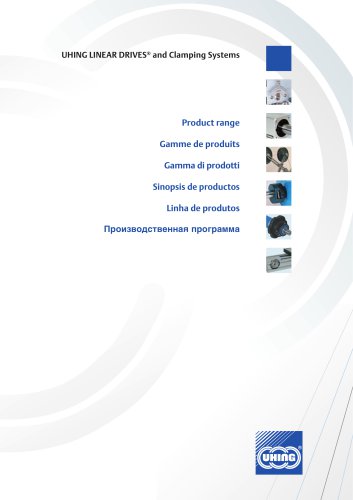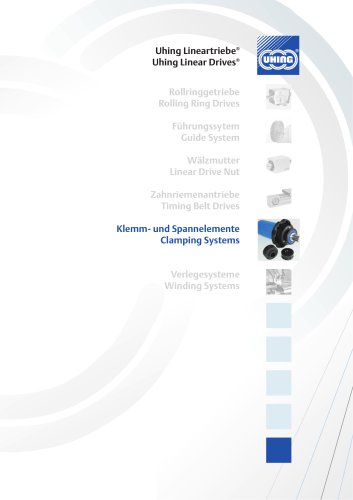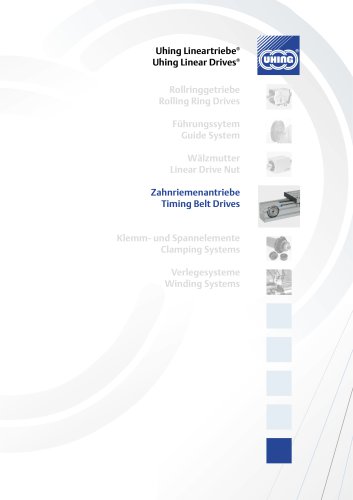
Catalog excerpts

1. General information Your Benefit: -No readjusting of reversal points after spool change-No readjusting during winding -Easy to install -Low price The Uhing non-contact FA flange detectingsystem provides a cost-effective means to automate required corrections of rolling ring dri- ve reversing points tried and tested in conti- nuous industrial application.The traversing system incessantly distributingthe material between the spool flanges is only rarely regarded as a cost factor. This only occurs when a conversion to new material dia- meters or coil widths is necessary. The setting then...
Open the catalog to page 2
Abb. / Fig. 1 Power requirements: Power supply:85 - 264 V A.C., 47 - 63 Hz Compressed Air:4 bar Funktion: Ein Sensor (Lichtschranke) erfat die Spulen- flansche und leitet die Bewegungsumkehr der Verlegung ein. Nimmt die Drehzahl der Verlege- welle mit zunehmendem Fllgrad der Spule ab, verkrzt sich der Hub, da die Umschaltzeit kon- stant bleibt. Um diese Hubverkrzung auszu- gleichen, kann eine SPS mitgeliefert werden. Function: A sensor (light barrier) detects the coil flanges and trips the reversal of the traversing unit. When the speed of the traversing shaft decrea- ses proportional to...
Open the catalog to page 3
3. Variants3.1 Usually the FA is operated at constant tra-versing speed 3.2 The traversing system is driven by the tra-versing shaft via a belt drive at during winding. This traversingsystem variant features a drive motor of its own and a bistable relay controller allowing the time between flange detection and reversing impulse to be adjusted. For notes on the relay controller refer to item 7.1. 2. Description 3.3 To prevent profiled material from droppinginto the gap between the last winding and the flange a brief stop of the traversing system before reversal is often useful. For this...
Open the catalog to page 4
4. Anschlsse4.1 Elektrisch: 4. Connections4.1 Electric: Betriebsspannung 230 VAC, 50/60 Hz. Operating voltage 230 VAC, 50/60 Hz. 4.2 Pneumatisch 4.2 Pneumatic (Abb.2):4,5 bis 6 bar. (Fig. 2): 4.5 to 6 bar. > Abb.2:pneumatisches Anschluschema f쟼r FAFig.2:Pneumatic connection for FA size="-1">
Open the catalog to page 5
4.3 Mechanic (Fig. 3):Install the traversing system such that the swi-velarm shaft (1) of the light barrier (2) points towards the coil axis (3). Variant 3.2 also requires a connection between winding and traversing shaft by means of a toothed belt or similar. > 4.3 Mechanisch (Abb.3):Die Verlegung muss so eingebaut werden, dassdie Achse des Schwenkarms (1) der Licht- schranke (2) auf die Spulenachse (3) weist. Bei Variante 3.2 ist auerdem die Verbindung von Wickel- und Verlegewelle mittels Zahnriemen o.ߤ. erforderlich. > Abb. / Fig. 3 Abb. / Fig. 4 size="-1">
Open the catalog to page 6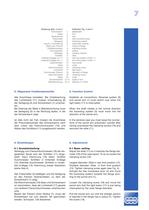
5. Function Control Establish all connections. Reversal system (6)and swivel arm (1) must switch over when the light beam (17) is interrupted.When the shaft rotates in the normal directionthe traversing system (5) must move into the direction of the swivel arm. In the adverse case you must swap the connec-tions of the swivel arm pneumatic cylinder after having unscrewed the clamping screws (16) and removed the slide (11). 6. Adjustments6.1 Basic setting Adjust the slide (11) so it matches the flange dia- meter (18) of the used spool. To do so loosen the clamping screw (16). Largest...
Open the catalog to page 7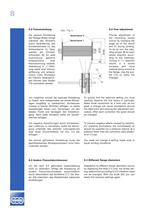
6.2 Fine adjustment Precise adjustment ofthe traversing stroke occurs by changing the angle (a) of the swivel arm (1) during winding. To do so turn the adju- sting screws (8) for each stroke direction accor- ding to the markings. Turning in +ԓ direction results in a stroke increase and morematerial being wound atthe flange. Use the sca- les (15) to verify the changes.To quickly find the optimum setting you mustcarefully observe the first layers in particular. Make small corrections at a time only as too great a change will cause oscillations around the ideal point and prolong the adjustment...
Open the catalog to page 8
Anschl줼sse: Ausgnge PneumatikLichtschrankensensorsiehe 7.1.3Drehbereich derPotentiometer 360(10-Gang)optional: externesPotentiometer taN/L 230VAC; 50/60 Hz Connections: Exit PneumaticLightbarrier Sensorsee 7.1.3rotation ofPotentiometer 360䰰 (10 gears)Options: externalPotentiometer taN/L 230VAC; 50/60 Hz 0V 12 0V 14 0V E1 +24V ta HSL tb NC NL >
Open the catalog to page 9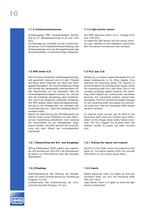
7.1.3 Light barrier sensor Exit PNP, darkness switch on E1. Voltage at 0Vand +24V (DC).To install the light barrier and the sensor sensi- vity pay attention to the installation instructionsfrom the sensormanufacturer (are enclose). 7.1.3 Lichtschrankensensor Schaltausgang PNP, dunkelschaltend (Schlie-er) an E1. Betriebsspannung an 0V und +24V (DC). Zur Montage der Lichtleiter an den Lichtschran- kensensor und Empfindlichkeitseinstellung des Schaltzustandes sind die Montagehinweise desSensorherstellers zu bercksichtigen (Beipack). 7.2.1 Testing the inputs and outputs Set PLC to the 'RUN'...
Open the catalog to page 10
Joachim Uhing KG GmbH & Co. Kieler Strae 23 24247 Mielkendorf Telefon+49 (0) 4347-906-0 Telefax+49 (0) 4347-906-40 e-mail: sales@uhing.com http://www.uhing.com Germany > BKInpress 8166 size="-1">
Open the catalog to page 12All UHING catalogs and technical brochures
-
Rolling ring drive RG_ARG
74 Pages
-
Product Range
24 Pages
-
Timing Belt Drive AZ
16 Pages
Archived catalogs
-
Rolling Ring Drive
28 Pages
-
easylock ® / U-Clip
12 Pages





